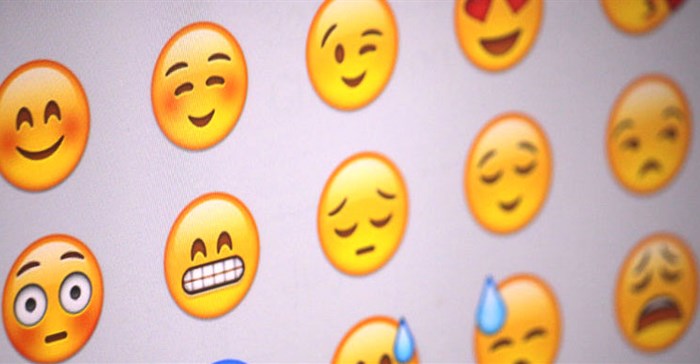
Top stories






Marketing & MediaTake a trip down the wilder side of memory lane on the History Channel this January
Hearst Networks Africa 1 day
More news

























It is all about 'feelings' today - we add the appropriate emoji's to our emails, our sms's, WhatsApp, and of course on Facebook, which started it all by asking us to share our feelings every day with leading questions and a like button for your friends' posts.
It's as if adding a happy face and clapping hands to a "congrats" post or a crying or sad face to a "bad news" post, amplifies our feelings: "I'm REALLY REALLY happy for you" or "I'm EXTREMELY sorry for your loss".
This visual language has become so much a part of our communications, that even emails to clients contain smiley faces.

My toddler, who doesn't read or write yet, communicates with absent loved ones via emoticons. She loves being able to send smiley faces, hearts, kitties, bunnies, etc, to me and the rest of the family when one of us is not with her. She delights in being able to communicate with us with her "moticons", and prefers it to speaking on the phone.
But does it belong on the front page of a newspaper to peg an emotion to a story? Will we be seeing 'smiley or crying faces' next to TV news bulletins soon to tell us how we should be feeling? I've seen ad copy written in emoticons and emojis, ditto article headlines, covers and story images.
To mark the occasion of Facebook's new 'dislike' button, which is actually a new series of emojis added for emphasis on posts, USA Today newspaper used 'emojis' to attach emotions to their front page news stories. It was termed "awkward" by AdFreak and they were slammed for editorialising and being "flippant".
USA Today denied it was a stunt and the editor, David Callaway, told AdFreak that they were tapping into a trend: "My feeling (as editor-in-chief) is that a billion FB users may soon start using these to share stories-all kinds of stories-which of course is Facebook's intention. Social media and its icons are becoming a dominant form of communication in our world. We wanted to show what they would be like if transferred to print."
My immediate reaction is that this is editorialising - indicating to people how they should feel about the news, when we need to present the facts and leave people to make up their own minds about how they then feel.
But I wonder if, in a world where we are measuring our reactions and attaching visual emotional representations to them in all other communication, how long this will last? Tabloid headlines already scream shock and horror; reality TV stars share what they were born in; the lines are blurring between advertising and editorial with content marketing - because hey, we all love a good story that taps into our emotions...
Facebook knows this. Advertisers know this. The Wall Street Journal even reported on Facebook's expansion of "its emotional range". How it works is that Facebook users will be able to hold down the 'like' button to broaden their range of expression with seven new emojis: angry, sad, wow, yay, haha, love and the traditional 'like' thumbs up.
It's all based on Facebook's own research in studying which emotions we express the most on Facebook all around the world. Facebook's 'Reactions' are being tested in Ireland and Spain first and were deemed by Facebook to be an "elegant and fun" solution instead of just a 'dislike' button which may lead to cyber-bullying, it was feared.

Visual influence is a top trend for this year and in an academic paper delivered in 2001 at a National Science Foundation Conference, it was predicted that the 15 years to the year 2015, and beyond, would result in visual language and converging technologies creating a new form of communication. The author of the paper, Robert Horn, a visiting scholar at Stanford University, wrote: "When words and visual elements are closely intertwined, we create something new and we augment our communal intelligence."
He was of course not referring to anything as 'frivolous' as emojis as social media hadn't yet been invented and smartphones were an emerging technology, but he did predict that as convergence occurred from developments in tech, that visual language would enhance our ability to communicate, teach and work in new fields. He was referring to mechanical drawings, charts, cartoons, visual metaphors and filmed narrative.
Where social media and sites like YouTube and the infographic trend have taken us, is a result of this convergence that he talks about. In fact, Professor Josiah Kahane explains further in Fast Company magazine that "the ability to think and communicate in visual terms-both the understanding and conception of the visual-becomes of equal importance with that of literacy and numeracy in today's learning process."
We are at this point because we like communicating with visuals as well as words. Because it speeds up communication. Because we can convey a range of emotions with a single key stroke, instead of a sentence.
Facebook knows this. USA Today editors recognise this. So editorialising it may be, but we will see more such iconography appearing as part of today's media because media and advertising reports on and reflects society and emojis and emoticons have become part of our daily social construct. Like it :) or not :(!

TRENDAFRiCA is a trend watching portal on consumer insight, research and trends from South Africa and further afield on the continent of Africa. It includes DAiLY trends headlines from around the world, influential Trendspotter columnists and in-depth reports on industry segments. Louise Marsland is the founder and editor.
Go to: www.trendafrica.co.za